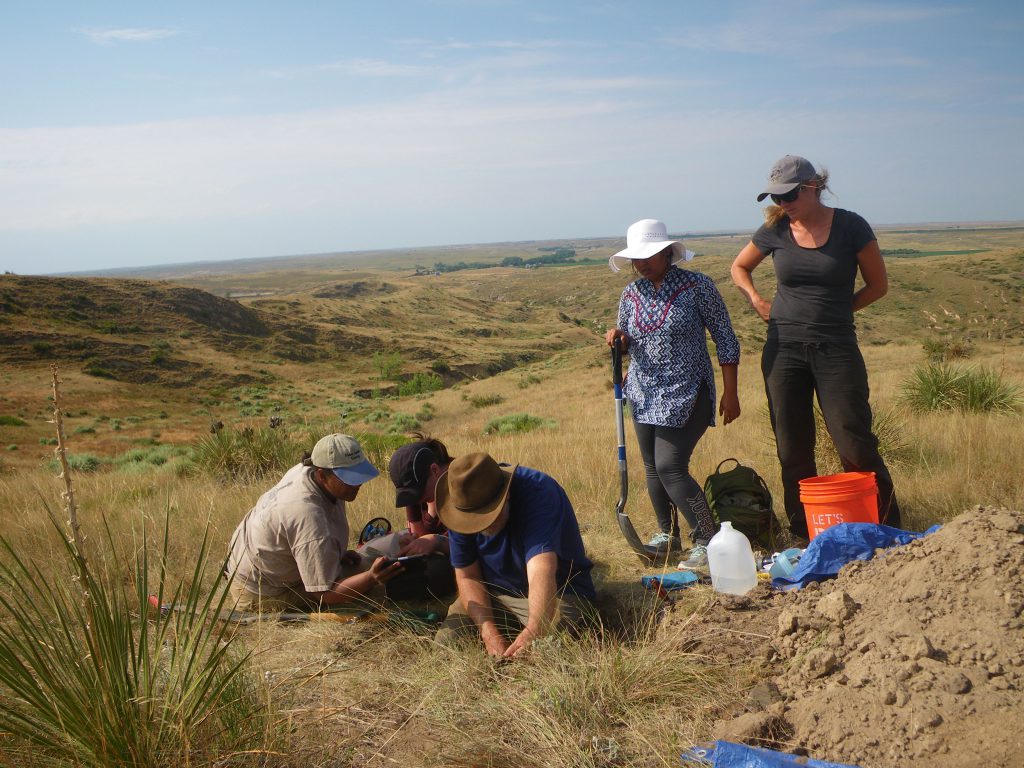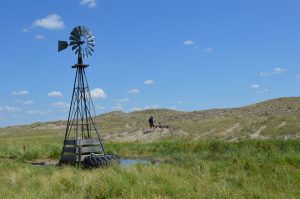
The UW-Madison Geography Department has four major thematic areas: Physical Geography, People-Environment, Human Geography, and Cartography/GIS. This year, we will feature each sub-area to highlight the diversity of research and teaching in the department and celebrate the achievements of faculty and students.
Our inaugural post features the Physical Geography sub-area, with research across a wide range of geographic and temporal scales!
Joe Mason, Erika Marin-Spiotta and PhD student Laura Szymanski are collaborating on a project in Nebraska to study the vulnerability of ancient carbon in buried soils to changes in the landscape and climate. Laura was an instructor at UW Platteville in the Fall and is co-teaching Geography 120 on campus this Spring. Members of the Marin-Spiotta group have been involved in aiding relief efforts after Hurricane Maria landed in Puerto Rico, which is home to one of our students and also site of ongoing research since 2001. PhD students Elliot Vaughan and Ricardo Rivera and undergraduate student Sanober Mirza (recently profiled) traveled to the island to assess damage and connect with local collaborators and communities. The three students are working in Puerto Rico, studying the effects of land-use conversion and nitrogen fertilization on soil carbon, changes in soil nutrients and plant communities during post-agricultural reforestation and nitrogen availability during forest recovery. Elliot is also a Scientific Teaching Fellow with WISCIENCE. Lab manager Ann Olsson is writing up her work on fire effects on stream chemistry in Alaska and the results of a litter decomposition study in dry forests in the Caribbean. The Biogeolab also hosts undergraduate researchers Diana Tapia, Olivia Lopez, Craig Kunkel and Cat Kirwin and recent Geography alum Liam Patton, who are contributing to several projects. Erika is leading a national project to develop bystander intervention and research ethics training to address harassment in academia.

Jack Williams, on sabbatical for 2017-2018, is working with research scientist Simon Goring (with many others) to build the Neotoma Paleoecology Database as a high-quality, community-curated scientific data resource to enable global-scale studies of species responses to past climate change. Neotoma data are freely open to all, and can be found on both Neotoma Explorer and the Flyover Country app for travelers. Jack and postdoc Allison Stegner are collaborating with UW-Madison faculty Monica Turner, Steve Carpenter, Tony Ives, and Chris Kucharik to understand and diagnose the causes of abrupt change in ecological systems (ACES). David Fastovich and new MSc student Allie Jensen are developing new records of late-glacial vegetation, temperature, and fire dynamics in the upper Midwest. PhD student Kevin Burke is studying the novelty of expected 21st-century climates relative to geological analogues, while PhD student Yue Wang completed her PhD in August 2018 and started a new postdoc at Georgia Tech, after completing her dissertation research into the timing and causes of woolly mammoth extinction on St. Paul Island, AK. Postdoc Mathias Trachsel, who arrived in Madison this fall, is working on building more accurate land-cover reconstructions from fossil pollen data networks.

Joe Mason and graduate student Kevin McKeehan sampled sites in the Nebraska Sand Hills and nearby dune fields in July, to launch Kevin’s M.S. research on soil, vegetation, and geomorphic feedbacks that may influence activation and stabilization of Great Plains dunes. Kevin returned later in the summer and got some valuable experience in finishing up field work fast to avoid getting trapped on bad roads by a Nebraska thunderstorm. Joe’s longstanding collaboration with researchers at Nanjing University produced two important new publications this year. One paper reported the first use of Nd and Sr isotopic composition to trace the sources of loess on the central Great Plains (which also involved rushing to collect samples between thunderstorms).
Another paper in press, with lead author Zhiwei Xu, documents recent rapid stabilization of a major dune field in northern China, at least partly in response to climate change. This work follows up on Zhiwei’s Ph.D. research, co-advised by Joe and Huayu Lu of Nanjing University. In December, Fei Ma successfully defended her Ph.D. dissertation, which involved modeling dune stabilization in the same dune field studied by Zhiwei.
Ken Keefover-Ring traveled to Alaska and China last spring and summer as part of his NSF Dimensions of Biodiversity grant to study differences in the chemical ecology of female and male trees in the plant family Salicaceae (poplars and willows). The Fairbanks, Alaska trip involved collecting samples of one poplar and several willow species, including the skeleton-leaf willow which grows on the arctic tundra and stands less than 10 cm in height. These and other samples are currently being analyzed for various chemicals that either attract pollinators or deter herbivores by Samantha (Sam) Harrow, a second-year graduate student in the lab, and by post-doc Dr. Muhammad Azeem. Ken also continued his work with Prof. Ken Raffa in Entomology on defense syndromes in pines, including a wide-ranging chemical analysis of two western pine species, one of which is the historical host for mountain pine beetle and the other a high elevation pine only recently exposed to this native, but very destructive herbivore due to climate change. The study showed that the historical host has evolved effective defenses against this outbreak herbivore, but the new host has not.



